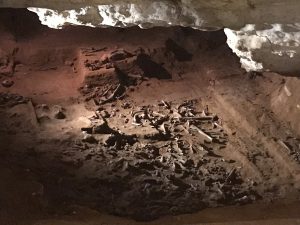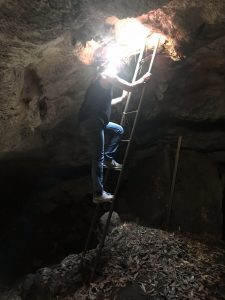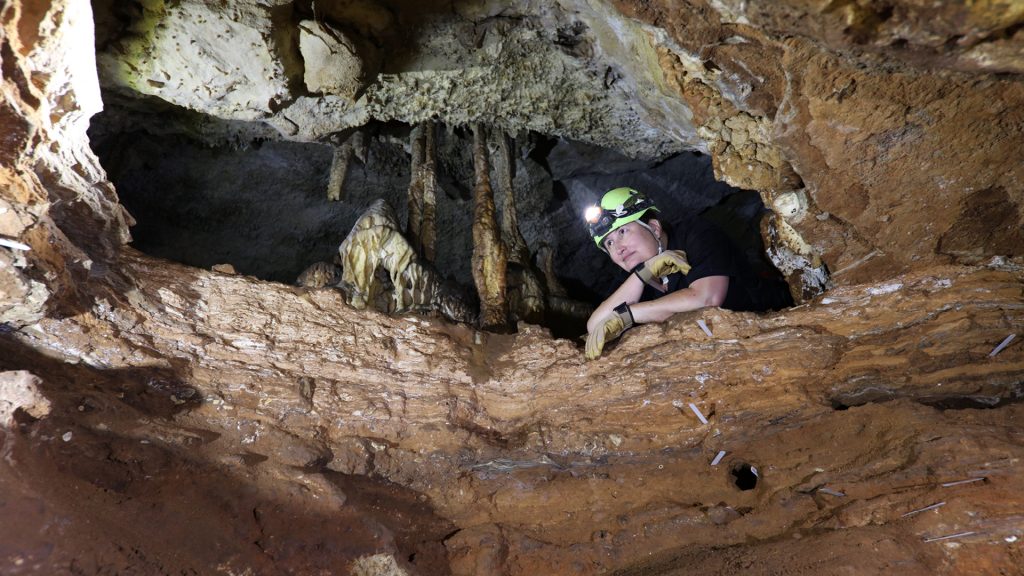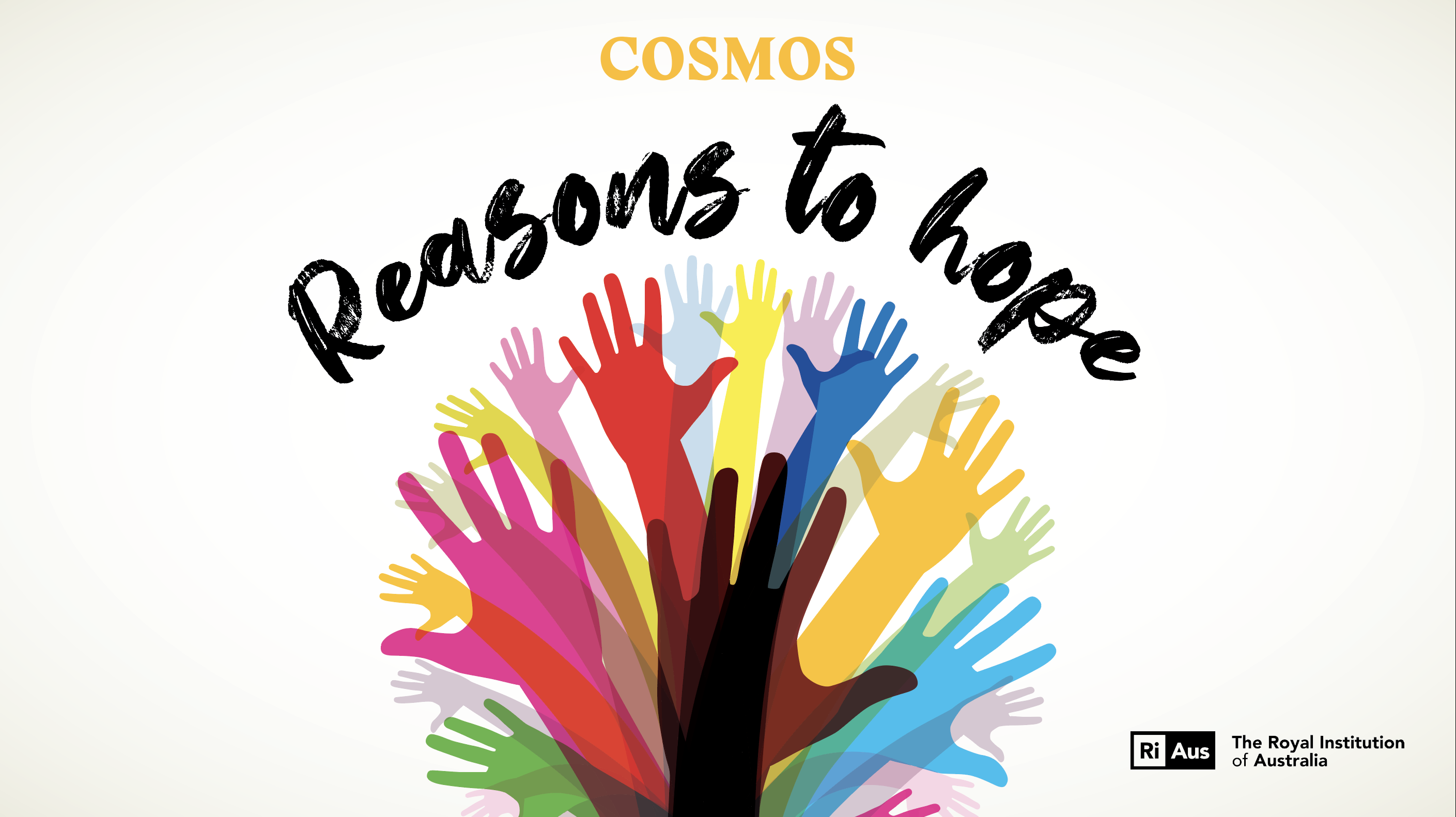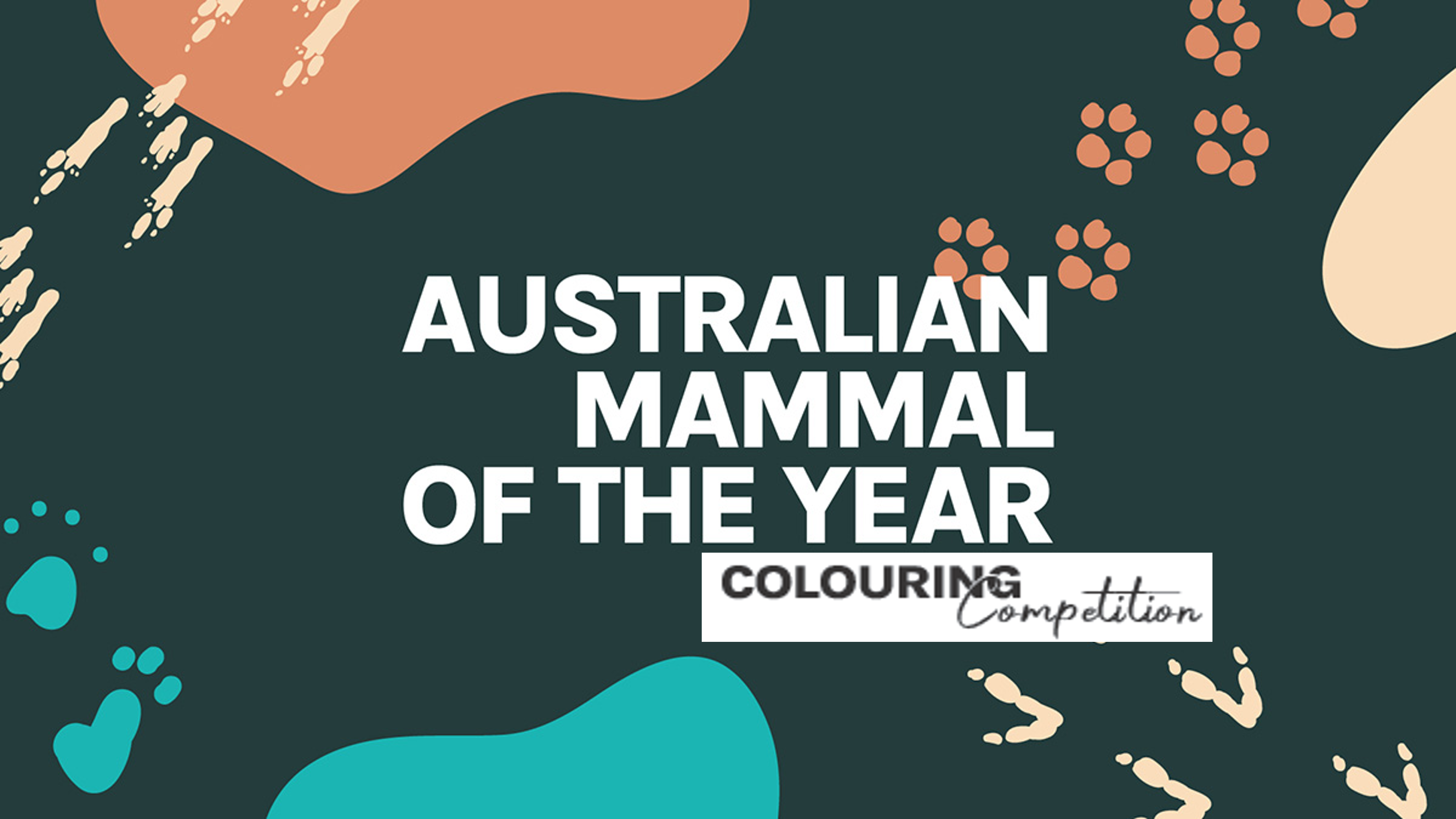The geological records below ground in Naracoorte, South Australia are relatively young, dating 500,000 years to less than 1000.
But researchers hope these records can inform conservation efforts about extinctions, adaptations, climate change and human impact. These fossils from the past might just be able to answer some of the big questions facing conservation efforts today.
This fascinating extended article from Cosmos 84 and associated activity would be suited to students in years 4–10, studying a range of STEM related topics.
Word count: approx. 2000
As the morning sun illuminates the parched bush surrounding Naracoorte in South Australia’s southeast, the locals start coming to life.
Lizards and snakes slither out to bask in its warmth and kangaroos hop out of sight while parrots screech in an excited flurry of activity. Koalas open their eyes and munch on eucalyptus leaves before drifting lazily back to sleep.
Below ground things are quieter, but, for palaeontologists such as Liz Reed, no less exciting.
The remains of long-gone animals – including extinct giant kangaroos (such as Procoptodon goliah), huge monitor lizards (Varanus priscus) and marsupial lions (Thylacoleo carnifex) – lie in a meandering network of caves, preserved by layers of sand.
These are some of the Earth’s richest, most detailed records of times gone by – the reason why the Naracoorte Caves earned a world heritage listing 25 years ago, fortifying its attraction for tourists.
“It’s kind of the Rolls-Royce record of biodiversity for the last half a million years,” says Reed, from the University of Adelaide’s Environment Institute.
Geologically, the records preserved in these caves from the Quaternary period are relatively young: dating back from at least 500,000 years ago to less than 1000. For this reason, they can inform conservation efforts through insights into extinctions, adaptation, climate change and human impacts after Europeans arrived.
Intriguingly, the megafauna that people now know only through reconstructed fossils existed alongside animals that hop, fly and crawl around today. By reconstructing ecosystem function, Reed hopes to understand why some animals survived, while others became extinct.
“We’ve lost over 60% of mammals in South Australia since settlement, which is just devastating,” she says. “For those few that remain, what does it mean for them? The only way we can understand their natural community dynamics is to look back.”
As a scientist dedicated to refining and expanding current fossil records and preserving the fragile caves, Reed recognises the importance of balancing the research and conservation with regional tourism.
“If you think of those things as three circles coming together, the middle is where you want to be, where all of those are in balance. And when one gets out of whack, nothing works.”
Reed’s close relationships with the local community, government and landowners over the past 20 years helped win her research group a four-year, $2 million Australian Research Council (ARC) Linkage grant in 2017.
The multi-disciplinary team is applying state-of-the-art technologies – from DNA and isotope analysis to radiocarbon dating – to reveal new insights into biodiversity and climate change.
They will tap into the caves’ integrated record of time through delicate layers of vertebrate and invertebrate animal fossils, plant residues, charcoal and sand fragments. These can be analysed against a backdrop of speleothems (stalactites and stalagmites) which provide long-term rainfall and climate records.
“The caves are nature’s history books – you just have to learn the language,” Reed says. “And we keep finding out that the alphabet has more letters than we thought.”
Uniquely, visitors can see the scientists at work during cave tours, continuing a tradition of sharing fossil science with the public.
“So we have this great thing where our science is fresh from the ground, straight from the horse’s mouth,” Reed says.
After Blanche Cave was first discovered in 1845, the public was given free access – and left rubbish, graffiti and damaged speleothems in their wake. Eventually the caves were shut down and the park was declared a reserve. In 1885 the first tours started.
In the early days, the caves were presented as a fantasy land. When Reed and colleagues did some cave cleaning and rehabilitation, they even found little statues of fairies that had been used as props.
“It wasn’t the science of it. It was this adventure and mystery. That’s what people expected and that’s what they got.”
The caves hold their own special power, but communicating the science is vital, Reed believes, to make people care about cave conservation and biodiversity.
“You can go in one door and come out the other a different person or have a different view, and that’s where the power of good science communication comes in,” she says.
“You might have someone come in and say, ‘I really hate bats’. They go on a bat tour and they go, ‘Oh, bats are actually pretty cool’.”
Fossil tourism was born out of an idea of Reed’s PhD supervisor, Rod Wells. Fifty years ago, he and a team of cave explorers followed their flickering gas lamps through tight gaps in the crystalline Victoria Cave and stumbled across hidden limestone chambers containing “the palaeontological equivalent of King Tutankhamen’s tomb”.
The discovery revealed exquisitely preserved bones from more than 135 different amphibians, reptiles, birds and mammals, including nearly 20 species of megafauna and nine extinct kangaroo species.
“We’ve basically got the motherload in here; it’s ridiculously huge, this deposit,” Reed says. It’s now known as the Fossil Chamber, and she estimates it’s the size of three Olympic swimming pools – seven metres deep in places.
Wells, an unusually entrepreneurial scientist, wrote to the government proposing an underground museum to help sponsor further research, resulting in a centre where people could watch and ask questions of palaeontologists while they excavated.
“And that sort of set the stage for where we are now, and probably why there’s such a strong foundation in us communicating our work so closely with the staff here,” Reed explains.
The staff provide guided tours to showcase fossil remains and crystalline deposits in the caves and reconstructed megafauna specimens in a visitor’s centre. Greeting tourists at the centre is a reconstructed skeleton of the so-called marsupial lion, Thylacoleo carnifex, wrestling with a giant snake, Wonambi naracoortensis. Despite its name, it’s not related to lions; it comes from the order Diprotodontia, which includes wombats, kangaroos and koalas. It was Australia’s largest known carnivorous mammal and was an integral constituent of the megafauna roaming the Naracoorte region.
“Thylacoleo, he’s a bit of a superstar,” Reed laughs. “It’s like the T.Rex of Naracoorte.” But she would prefer the historic animals – which were given European names like Tirchosurus vulpecula for the brush-tailed possum, meaning hairy-tailed fox – to be referred to by their Aboriginal names.
“Then it’s a uniquely Australian name for a uniquely Australian animal.”
Reed delicately unearthed fossilised T. carnifex remnants from a large pit for her PhD in 1998 – with a dental pick. Palaeontology is not for the faint-hearted. “It is absolutely tedious at times; painstaking, patient work,” she says.
Some of the fossil bones are like wet cardboard – they could easily disintegrate into a handful of powder if not managed extremely carefully. Even before removing the bones, everything is forensically measured. The researchers do XYZ coordinates of each bone’s position and describe, photograph, draw and now 3D scan it to ensure the context and age is recorded accurately.
“And for every hour we spend in here, we’d spend 20 in the lab just sorting through deposits,” Reed says, adding that each dig can generate hundreds of thousands of specimens.
But the thrill of discovery is unimaginable. Nearly two decades ago, Reed unearthed the remains of a giant monitor lizard – the first time it had been found in Australia’s south. She and her partner Steve Bourne – then manager of the World Heritage area – found it on a vineyard. Many new caves have been discovered by winemakers in the region, who call the scientists and section them off for their work.
It turned out the cave was an ancient den for Tasmanian devils (Sarcophilus harrisii), becoming the second site in the region that revealed the use of caves as carnivore lairs. (Most of the others contain pitfall deposits from unsuspecting animals that fell into them.)
When Reed and colleagues did some cave cleaning and rehabilitation. they even found little statues of fairies that had been used as props.
The giant lizard was reconstructed as part of a three-dimensional art display of the Pleistocene era, complete with animal sounds, lighting and flora, at the visitors centre. When people walk into the room, they can experience in an instant what Reed says would take hours to convey in words.
A few years after the giant lizard discovery, Reed and her partner received a call from a landowner who had uncovered a deep hole during vineyard preparations. Using a ladder, they climbed down by the light of their headlamps and discovered a chamber full of stalactites, before moving gingerly through the humid cave.
On their way back, Reed looked up and spotted whale bones deposited in the limestone from an era when the region was underwater. “So we were very excited about that,” she says. “But what we missed coming in, on the left, was another branch.” Following that they found a rich, untouched deposit of megafauna bones.
“But you know with that privilege of excitement and adventure of being the first in comes a huge responsibility. You don’t want to be the first in and also the first one to completely wreck the cave.”
The landowner installed a locked entrance to protect the site and is one of the partners on the grant, which includes exploring the deposits further.
Already, one of Reed’s students has found remains of 16 giant kangaroos and the first record of small vertebrates, including rodents and pygmy possums (from the family Burramyidae).
“So we’re really closing in and building up that continuous half-a-million-year record,” she says.
Reed is happiest when immersed in the caves’ cool, serene darkness, covered in dirt and hidden from the world. “Isn’t it wonderful,” she whispers during a cave visit. “It’s such a detox to come down here, and it’s quiet and there’s nothing else, no nonsense.”
Her passion to tell the cave fossils’ stories to the public and to new generations of scientists won her the South Australian Science Excellence Award for unsung hero of science communication in 2018.
“Part of my mission, I feel, is getting people to understand that these aren’t just dead things that we put pretty lights on,” she says. “These are probably the most fragile terrestrial ecosystems on the planet.”
She donates her time generously to communicate fossil science and inspire respect for the caves, from her past work as a tour guide and affiliation with the South Australian Museum as honorary research associate, to the fossil club she runs with school children.
One little boy who had been struggling with reading and engagement, according to his teacher, was so inspired by the fossils that he started reading about them and writing the labels himself. “That’s really lit a spark,” Reed says enthusiastically, “and he really wants to be a scientist now.”
Naracoorte’s mayor, Erika Vickery, says Reed is a “fantastic science communicator” and “the most wonderful advocate for the world heritage site, not just with promoting the site but getting young ones really involved too, and just as passionate as she is”.
Recognising the importance of the research for local tourism, the Naracoorte Lucindale Council is a major financial supporter of the ARC Linkage grant, along with the Department for Environment, Water and Natural Resources, the South Australian Museum, Terre à Terre, Wrattonbully Wine Region Association and the Defence, Science and Technology Group.
“If the caves are doing well, the region is doing well, and that’s underpinned by the science,” Reed says.
But ecotourism is complex. While it’s important to share the science and instil passion for conservation, tourists can interfere with the very ecosystems that need protection. To that end, new technologies offer a solution.
Already, techniques have advanced so much, Reed jokes that “10 scientists can work out of a teaspoon of dirt”.
Decades into the future, she foresees they probably won’t even need to dig: 3D laser scanning lets them map the caves in fine detail, and may one day enable virtual tours.
Reed hopes one of her students will take over and continue her work of fossil research and preservation. “I’d hate to see all this huge momentum and it not happen.”
As a group of people approaches with a tour guide, she muses that one of the kids might be her in 30 years’ time, then laughs. “I might be a fossil by then.”
This article was written by Natalie Parletta, freelance science writer based in Adelaide for Cosmos Magazine Issue 84.
Cosmos magazine is Australia’s only dedicated print science publication. Subscribe here to get your quarterly fill of the best Science of Everything, from the chemistry of fireworks to cutting-edge Australian innovation.
Login or Sign up for FREE to download the educational resources

